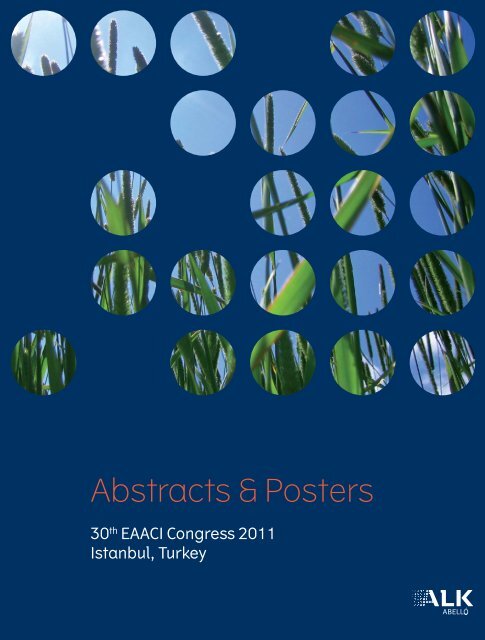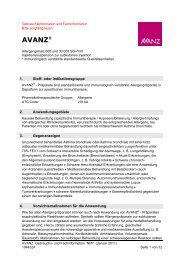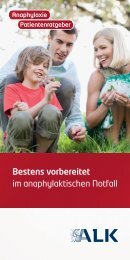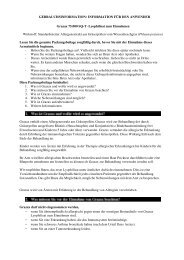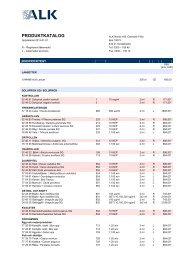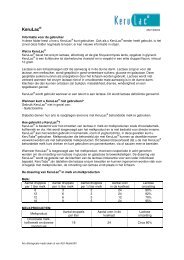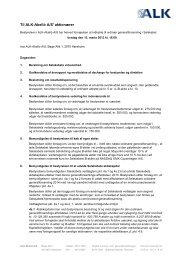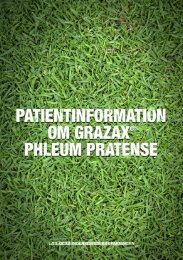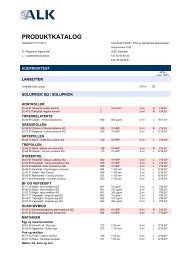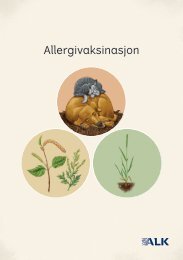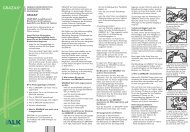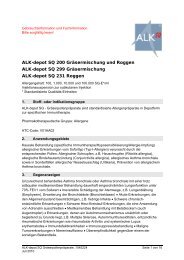EAACI 2011 Scientific Contribution.pdf - ALK-Abelló Group
EAACI 2011 Scientific Contribution.pdf - ALK-Abelló Group
EAACI 2011 Scientific Contribution.pdf - ALK-Abelló Group
You also want an ePaper? Increase the reach of your titles
YUMPU automatically turns print PDFs into web optimized ePapers that Google loves.
Abstracts & Posters30 th <strong>EAACI</strong> Congress <strong>2011</strong>Istanbul, Turkey
Dear Congress Delegate<strong>ALK</strong> welcomes you to the 30 th Congress of the European Academy of Allergology andClinical Immunology in Istanbul. As the world leader in specific allergy management, weare proud to present the results of our activities in the Research & Development area inthis year’s scientific programme. In total, more than 30 abstracts from <strong>ALK</strong> are acceptedfor presentation at <strong>EAACI</strong> <strong>2011</strong>.In this booklet, you will find the abstracts and posters covering our world leading allergyimmunotherapy products and basic science including information on date and time forpresentations.Among the highlights, you will find a report on patient recruitment and randomisation forthe Grazax ® asthma prevention (GAP) trial in which 1000 children were screened (page22). The collaboration with Merck aiming at introduction of allergy immunotherapytablets (AIT) in North America is featured in abstracts reporting Grazax ® data from apaediatric and an adult trial (pages 6 and 14) conducted by Merck in the US yieldingessentially similar results as those obtained in Europe. Several abstracts report Grazax ®post-marketing safety data, among these a large study including more than 600patients from France (page 18).Dear Congress DelegateThe house dust mite AIT is under development and a dose-finding trial showedsignificant reductions in steroid use needed to control symptoms in patients with mild tomoderate allergic asthma after one year of treatment. One of the abstracts presentedhighlights a subgroup analysis identifying a considerable higher benefit in patients withpartly controlled asthma as compared with the average study population, both withrespect to reduction in steroid use and improvement in quality of life (page 26).New areas for the use of subcutaneous immunotherapy includes initiation withAlutard SQ ® within the pollen season (page 34), and the use of subcutaneousimmunotherapy in children and adolescents using a new fast updosed hypoallergenicformulation (page 36). Sublingual drop immunotherapy is shown to be effective intreatment of respiratory allergy to Alternaria alternata (page 40) as well as non-grasspollens, such as parietaria, olive and ragweed (page 38).11 abstracts highlight the significance of <strong>ALK</strong> basic research. The topics include newtechnology based on mass spectrometry for identification of allergens as well as studiesof injection site physiology, analyses of human cells including regulatory T-cells andbasophils, mite allergy in China and immunoassays for allergen quantification.We also welcome you to our Company Sponsored Symposium: The advancement ofallergy immunotherapy – translation from clinical evidence to clinical practice inthe 21 st century on Sunday 12 June at 10.30-12.00 hrs. The venue is “Çamlica”.Enjoy the congress and please join us at our stand in the exhibition area to learn moreabout our products and ongoing allergy research activities at <strong>ALK</strong>.Henrik JacobiExecutive Vice President, Research & Development1
ContentsGrass AIT4 Treatment with SQ-standardised grass allergyimmunotherapy tablet impacted the number of dayswith low quality of lifeJS Andersen6 Efficacy and safety of SQ-standardised grass allergyimmunotherapy tablet in European and North Americanchildren and adolescentsA Bufe8 Meta-analysis supports that the efficacy of grassallergy immunotherapy tablets is comparable tosubcutaneous immunotherapyM Calderón10 SQ-standardised grass allergy immunotherapy tablettreatment did not result in asthma worsening insubjects with allergic grass pollen rhinoconjunctivitiswith or without seasonal asthmaR Dahl12 Favourable safety profile of the SQ-standardised grassallergy immunotherapy tablet – an overview aftermore than 50,000 treatment years of exposureE Dige14 Efficacy and safety of SQ-standardised grass allergyimmunotherapy tablet in European and North AmericanadultsS Durham16 Tolerability of the SQ-standardised grass allergyimmunotherapy tablet and patient satisfaction withtreatment in children, adolescents and adults duringroutine applicationC Gronke18 French experience: safety profile of SQ-standardisedgrass allergy immunotherapy tablet in medical practicefor 3 consecutive seasons – the GRAAL studyA Magnan20 Safety and tolerability of SQ-standardised grassallergy immunotherapy tablet in adults and childrenwith allergic rhinoconjunctivitis: post hoc analysis of 7clinical trialsH Nolte22 Recruitment for a trial investigating the preventiveeffect on asthma of an SQ-standardised grass allergyimmunotherapy tablet in children with grass polleninduced rhinoconjunctivitis (the Grazax ® asthmaprevention trial)G Roberts24 A comparative health economic evaluation of theSQ-standardised grass allergy immunotherapy tabletand subcutaneous immunotherapy in the treatment ofgrass pollen induced allergic rhinoconjunctivitisSM RonborgHouse Dust Mite AIT26 House dust mite allergy immunotherapy tablettreatment reduces the need for inhaled corticosteroidand improves quality of life in patients with partlycontrolled allergic asthmaF de Blay28 A European pattern of Der p 1 and Der f 1 allergenexposure in a house dust mite allergic populationH Mosbech30 Global initiative for asthma classification of asthmacontrol derived from the asthma control questionnairedataJC Virchow2
Subcutaneous Immunotherapy32 Tolerability of a new 5-injection, fast updosed,hypoallergenic, Parietaria subcutaneousimmunotherapy formulation: the AVANZ ® tolerabilityobservational surveyN Musarra36 Immunotherapy with a fast updosed hypoallergenicSCIT formulation: a retrospective study on tolerability inchildren and adolescentsD SchlegelContents34 Intra-seasonal short-time updosing withSQ-standardised subcutaneous immunotherapy inpatients with intermittent allergic rhinoconjunctivitis iswell tolerated during routine applicationR ReiberSublingual Immunotherapy Drops38 Non-grass pollen respiratory allergies in Italy andefficacy of specific sublingual immunotherapy drops:the rainbow trial; a multicentre, 3-year prospective,observational studyM Milani40 Efficacy of sublingual specific immunotherapy drops inpatients with respiratory allergy to Alternaria alternata:a randomised, assessor-blinded, patient-reportedoutcome, controlled 3-year trialM MilaniBasic Research42 During nasal challenge test with aqueous Phleumpratense, measurements of nasal peak flow andtotal nasal symptom score are normalised 6 hours postchallengeK Aasbjerg44 Production and characterisation of monoclonalantibodies for the study of Sal k 1 in Salsola kali pollenP Boissy46 Isoallergen profile recognition by the mAb used in anELISA for Bet v 1 quantitationL Castro48 Development of an immunoassay to quantify purifiedallergens based on the competition of the binding tosolid phase based specific IgEA Galán50 Ragweed allergomics: identification of allergens in anAmbrosia artemisiifolia pollen extract using a“shotgun” liquid chromatography tandem massspectrometry approachL Harder52 Indoor allergen levels in Guangzhou city, Southern ChinaX Lai54 Investigation of human basophils as antigenpresenting cells for established T-cell linesG Lund56 Alum formulated vaccines with single species grasspollen extracts and mixtures of extracts from multiplephylogenetically related grass species activate allergicpatients’ basophils to the same degreeG Lund58 Detection of bee (Apis mellifera) venom componentsin situ by Matrix assisted laser desorption/ionisationmass spectrometry imagingU Seppälä60 Inhibition of grass allergen specific T-cell responsesby CD4 + CD25 + CD127 lo regulatory T-cellPA Würtzen62 Specific IgE prevalence and cross-reactivity of housedust mites and storage mites in asthmatic childrenfrom Haikou, ChinaY Zheng3
Treatment with SQ-standardised grass allergy immunotherapy tabletimpacted the number of days with low quality of lifeJS Andersen 1 , SB Bæch 1 , SR Durham 2 (presenting)1Global Clinical Development, <strong>ALK</strong>, Hørsholm, Denmark; 2 National Heart and Lung Institute, Imperial College, London, United KingdomGrass AITBackgroundThe quality of life of patients with allergic rhinoconjunctivitisis often impaired due to symptoms such as nasalobstruction and rhinorrhea, frequently resulting in sleepdisruption. The purpose of this study was to investigate howthe number of days with severe symptoms (severe days)impacts the rhinoconjunctivitis quality of life and how thetreatment with a grass allergy immunotherapy tablet (AIT)impacts the frequency of severe days.MethodData from a multicentre, double-blind, randomised,placebo-controlled trial of 5 years’ duration (3 years ofdaily treatment and 2 years of follow-up) with the grassAIT (Grazax ® , Phleum pratense, 75,000 SQ-T/2,800 BAU,<strong>ALK</strong>, Denmark), were used. 6 rhinoconjunctivitis symptoms(4 nose and 2 eye) rated on a 4-point scale from 0 (nosymptoms) to 3 (severe symptoms) were recorded on adaily basis. Quality of life was assessed with the Junipersrhinoconjunctivitis quality of life questionnaire (RQLQ) on aweekly basis in terms of 7 domains each rated on a 7-pointscale from 0 (not troubled/none of the time) to 6 (extremelytroubled/all of the time). Post hoc, the numbers of weeklysevere days in at least 1 of the 6 symptom categories weremerged with the RQLQ replies the same week (12324 datapoints) and analysed using cubic B-splines and logisticregression.ResultThe RQLQ score increased (= lower quality of life) with thenumber of weekly severe days. For example, the RQLQ scorewas 3.7 times higher for subjects with 4 or more weeklysevere days (mean score: 2.93) than for subjects with noweekly severe days (mean score: 0.79), see table below.Treatment with grass AIT significantly reduced the oddsof having severe days relative to placebo, p
Grass AIT5
Efficacy and safety of SQ-standardised grass allergy immunotherapy tabletin European and North American children and adolescentsA Bufe 1 , B Tholstrup 2 , J Maloney 3 , MS Blaiss 41Experimental Pneumology, Ruhr University Bochum, Bochum, Germany; 2 Global Clinical Development, <strong>ALK</strong>, Hørsholm, Denmark; 3 Merck & Co, Kenilworth, UnitedStates; 4 University of Tennessee Health Science Center, Memphis, United StatesGrass AITBackgroundGrass allergy immunotherapy tablets (AITs) have beenavailable in Europe since 2006 and are in development forthe North American (NA) markets. Grass AIT is indicated totreat patients with moderate to severe grass pollen inducedallergic rhinoconjunctivitis whose allergy is inadequatelycontrolled by symptomatic medication. Here, we discussthe results from the European (EU) and NA phase III trials inchildren and adolescents.MethodBoth trials were randomised, double-blind, placebocontrolled,multi-centre trials with 1:1 randomisation (AIT:Grazax ® , Phleum pratense, 75,000 SQ-T/2,800 BAU, <strong>ALK</strong>,Denmark, or placebo). The subjects included were childrenand adolescents (5-17 years of age) with a clinical historyof (northern) grass pollen induced rhinoconjunctivitisand diagnosed with a positive skin prick test and specificIgE test to (northern) grass pollen. Subjects with allergicsymptoms caused by other allergens than grass pollenduring the grass pollen season were excluded. Outcomemeasures included symptom and medication scores(total combined and average daily), global evaluation/rhinoconjunctivitis quality of life (RQLQ), immunologicalmeasures and adverse events.ResultThe EU trial included 253 and the NA trial 344 subjects.Both trials met their primary endpoints. The total combinedsymptom and medication score was significantly reducedcompared with placebo in both trials (EU trial: 24% reduced(p=0.0216); NA trial: 26% reduced (p=0.001). The EUglobal evaluation showed that 74% of AIT subjects ratedan improved or much improved response compared withprevious pollen season (66% in placebo group, p=0.164).For the NA trial, an 18% reduction (p=0.042) relative toplacebo in RQLQ score was seen for AIT subjects during thegrass pollen season. Significantly higher inductions of IgG4antibodies and of IgE-blocking antibodies were observedfor the AIT group compared with the placebo group. Inboth trials, adverse events were mostly mild to moderatetransient application site reactions (itching and swellingin the mouth), and only few subjects withdrew from thetrials due to adverse events (EU: AIT group 3%, placebogroup 2%; NA: AIT group 7%, placebo group 3%). Systemicadverse events were rare in both trials.ConclusionSQ-standardised grass AIT treatment has been shown tobe clinically effective and well tolerated in both Europeanand North American children and adolescents.6Abstract number: 503. Session date and time: Sunday 12 June, 12.00 - 13.30Session: Poster session – Pediatric aspects of immunotherapy. Session room: Rumeli Hall
Grass AIT7
Meta-analysis supports that the efficacy of grass allergy immunotherapytablets is comparable to subcutaneous immunotherapyM Calderón 1 , JS Andersen 2 , S Lawton 31Section of Allergy and Clinical Immunology, Imperial College, NHLI, London, United Kingdom; 2 <strong>ALK</strong>, Global Clinical Development, Hørsholm, Denmark;3<strong>ALK</strong>, Medical Affairs, Hørsholm, DenmarkGrass AITBackgroundSubcutaneous immunotherapy (SCIT) and sublingualimmunotherapy (SLIT) have been shown to be effectivein the treatment of allergic rhinoconjunctivitis. Recentmeta-analyses suggest the magnitude of effect is greaterwith SCIT, but significant heterogeneity calls for carefulinterpretation of these data. To reduce clinical andmethodological heterogeneity, we performed a metaanalysison grass immunotherapy trials alone and furtherseparated sublingual treatments into SLIT drops and allergyimmunotherapy tablets (AIT).MethodWe conducted a search of MEDLINE, Embase and theCochrane Library. The search was limited to Englishlanguage literature published until December 2010. We onlyconsidered randomised, double-blind, placebo-controlled(RDBPC) trials of commercially available SCIT, SLIT dropsand AIT modalities for treatment of grass induced allergicrhinoconjunctivitis. The articles were cross-checked againstthose identified in recent meta-analyses and reviews.The data regarding rhinitis or rhinoconjunctivitis symptomscores were extracted from the publications, and metaanalysiswas performed separately for the 3 respectivetreatment modalities.active, 1709 placebo). The main reasons for excludingtrials were: lack of double-blinding/randomisation,review articles, duplicate trials, utilised multiple unrelatedallergens, experimental preparations and insufficientrhinitis/rhinoconjunctivitis symptom data. Using a fixedeffect model, all 3 treatment modalities significantlyreduced rhinitis/rhinoconjunctivitis symptoms comparedwith placebo. Nominally the level of efficacy was greater forgrass AIT (SMD -0.41, 95% CI -0.51 to -0.31; p
Grass AIT9
SQ-standardised grass allergy immunotherapy tablet treatment did not resultin asthma worsening in subjects with allergic grass pollen rhinoconjunctivitiswith or without seasonal asthmaR Dahl 1 , H Nolte 2 , HS Nelson 3 , MS Blaiss 4 , A Bufe 5 , D Rehm 6 , SR Durham 71Aarhus University Hospital, Aarhus, Denmark; 2 Bispebjerg University Hospital, Copenhagen, Denmark; 3 National Jewish Health, Denver, United States;4University of Tennessee Health Science Center, Memphis, United States; 5 Experimental Pneumology, Ruhr University Bochum, Bochum, Germany; 6 Global ClinicalDevelopment, <strong>ALK</strong>, Hørsholm, Denmark; 7 National Heart and Lung Institute, Imperial College, London, United KingdomGrass AITBackgroundAllergic rhinoconjunctivitis (AR) and asthma are comorbidconditions, and specific immunotherapy is theonly treatment with the potential to treat both diseasessimultaneously and to prevent disease progression. Here,we present asthma related safety data of a grass allergyimmunotherapy tablet (AIT).MethodAll trials included subjects with grass pollen AR with orwithout diagnosed seasonal asthma. Subjects withuncontrolled asthma were excluded. Safety data werepooled from 5 adult and 2 paediatric randomised, placebocontrolledtrials with the SQ-standardised grass AIT(Grazax ® , Phleum pratense, 75,000 SQ-T/2,800 BAU, <strong>ALK</strong>,Denmark), comprising 2096 adults (5 phase II/III trials) and598 children 5-17 years of age (2 phase III trials). Asthmarelated adverse events (AEs) were captured both in thee-diary as asthma symptoms and recorded as AEs. Thefrequencies of events were compared between the activetreatment and placebo groups in subgroups of subjectswith and without diagnosed asthma. The selected adverseevents were: asthma, dyspnea, wheezing, cough, chesttightness or discomfort and exercise induced symptoms.ResultIn adults diagnosed with asthma (n=516), there werefewer reports of asthma related AEs in the grass AIT group(59.6%) than in the placebo group (66.8%); and for adultsnot diagnosed with asthma (n=1,580), it was 48.9% (grassAIT) and 46.9% (placebo). In children diagnosed withasthma (n=190), there were fewer reports in the grass AITgroup (86.7%) than in the placebo group (94.6%); and inchildren not diagnosed with asthma (n=408), it was 74.0%(grass AIT) and 80.4% (placebo). Asthma and dyspneaincidence was low in adults (≤1.5%) and in children(≤4.0%). In children, 3 serious adverse events (SAEs) werereported related to asthma in the grass AIT group and 1 inthe placebo group. None of the SAEs were related to thetreatment. There were no asthma related SAEs reported inadults.ConclusionTreatment with the SQ-standardised grass AIT did notincrease the frequency of asthma related adverse eventsrelative to placebo in adults and children with grasspollen allergic rhinoconjunctivitis.10Abstract number: 761. Session date and time: Sunday 12 June, 12.00 - 13.30Session: Poster session – Clinical documentation of studies of efficacy and safety of IT. Session room: Rumeli Hall
Grass AIT11
Favourable safety profile of the SQ-standardised grass allergy immunotherapytablet – an overview after more than 50,000 treatment years of exposureE Dige, J Seyfarth, P FejerskovInternational Pharmacovigilance, <strong>ALK</strong>, Hørsholm, DenmarkGrass AITBackgroundAfter 4½ years of market presence, a patient exposure ofmore than 50,000 treatment years (TYs) has been achievedfor the grass allergy immunotherapy tablet (AIT), (Grazax ® ,Phleum pratense, 75,000 SQ-T/2,800 BAU, <strong>ALK</strong>, Denmark),known to have a favourable safety profile with mainly localnon-serious application site related reactions that aremild and transient in nature. This overview addresses theserious adverse events (SAEs, e.g. due to hospitalisationor medical importance, defined by the ICH E2A Guideline)reported in the adult and paediatric populations.MethodSAEs spontaneously reported post launch for adults andpaediatric patients were extracted from the <strong>ALK</strong> safetydatabase. Consistent with epidemiologic principles, theexposure for the grass AIT is presented as treatment years,equivalent to the number of patients treated for a full year.symptoms of dyspnoea and asthma) followed by localreactions (mainly symptoms of swollen tongue, lip swellingand palatal oedema) and finally systemic allergic reactions.3 systemic allergic reactions concerned adult patients whopreviously had discontinued subcutaneous immunotherapy(SCIT) due to intolerability; 2 of these occurred in theperiod prior to the grass AIT SmPC update in Jan 2009(20,000 TYs), where a precaution for use in this subgroupof patients was added. After more than 50,000 TYs ofgrass AIT exposure, no reports of systemic allergic reactionhave been assessed as life-threatening or as anaphylacticshock. No cases of swelling in the mouth have progressedto compromised respiration, neither in the paediatric norin the adult population. Relative to exposure, the numberof patients with previous adverse reaction to SCIT whoexperience a systemic allergic reaction to AIT is reducedconsiderably after the SmPC update in 2009 (1/10,000 TYsvs. 1/30,000 TYs).ResultA total of 90 treatment related SAEs have been reportedfor the grass AIT (children 20 SAEs; adults 70 SAEs) since2006, with a steady low frequency of 17-19 SAEs/10,000TYs reported yearly. In both the adult and paediatricpopulations, the primary reported SAEs were predominantlyreactions related to the respiratory system (mainlyConclusionAfter 4½ years of market presence and more than50,000 TYs of exposure, review of SAEs reported forSQ-standardised grass AIT supports the presentfavourable safety profile and confirms that grass AIT iswell tolerated and suitable for home administration.12Abstract number: 759. Session date and time: Sunday 12 June, 12.00 - 13.30Session: Poster session – Clinical documentation of studies of efficacy and safety of IT. Session room: Rumeli Hall
Grass AIT13
Efficacy and safety of SQ-standardised grass allergy immunotherapy tabletin European and North American adultsS Durham 1 , W Emminger 2 , B Riis 3 , H Nolte 4 , HS Nelson 51National Heart and Lung Institute, Imperial College, London, United Kingdom; 2 Allergie-Ambulatorium Rennweg, Vienna, Austria; 3 Global Clinical Development,<strong>ALK</strong>, Hørsholm, Denmark; 4 Merck & Co, Kenilworth, United States; 5 National Jewish Medical and Research Center, Denver, United StatesGrass AITBackgroundGrass allergy immunotherapy tablets (AITs) are used to treat(northern) grass pollen induced allergic rhinoconjunctivitisin patients suffering from moderate to severe pollen allergyinadequately controlled by symptomatic medication.Environmental and geographic variation may impactimmunotherapy treatment outcomes. Safety and efficacyof grass AITs have been evaluated both in European(EU) and North American (NA) adults with grass allergicrhinoconjunctivitis.Method2 separate trials, both randomised, double-blind, placebocontrolled,multi-centre trials with 1:1 randomisation (AIT:Grazax ® , Phleum pratense, 75,000 SQ-T/2,800 BAU, <strong>ALK</strong>,Denmark, or placebo) were conducted. Subjects includedwere adults (18 to 65 years of age) with a clinical historyof grass pollen induced rhinoconjunctivitis and diagnosedwith a positive skin prick test and specific IgE test to grasspollen. The NA trial included a baseline observational grasspollen season, and both trials included approximately16 weeks of pre-seasonal as well as seasonaltreatment. Primary outcome measures included dailyrhinoconjunctivitis symptom and medication scores, qualityof life, immunological measures and adverse events.ResultThe EU trial included 634 and the NA trial 438 subjects. Theseverity of the grass pollen season differed between the2 trials with Europe having the most robust grass pollenseason. Both trials met their primary endpoint. The totalcombined symptom and medication score was significantlyreduced in the AIT group compared with placebo in bothtrials (EU: 33% reduced (p
Grass AIT15
Tolerability of the SQ-standardised grass allergy immunotherapy tabletand patient satisfaction with treatment in children, adolescents and adultsduring routine applicationC Gronke 1 , H Wolf 2 , J Schnitker 3 , E Wüstenberg 41Paediatrician, Ludwigsfelde, Germany; 2 Clinical Development, <strong>ALK</strong>, Wedel, Germany; 3 Institut für angewandte Statistik GmbH, Bielefeld, Germany; 4 Medical &Regulatory Affairs, <strong>ALK</strong>, Wedel, GermanyGrass AITBackgroundThe fast-dissolving SQ-standardised grass allergyimmunotherapy tablet (AIT) became available for childrenfrom 5 years of age in 2008 in Germany and Austria. Theobjective of our study was to record data about tolerabilityand patient satisfaction in children, adolescents and adultsduring routine use of grass AIT.MethodIn a non-interventional observational study, 1,761 patients(797
Grass AIT17
French experience: safety profile of SQ-standardised grass allergyimmunotherapy tablet in medical practice for 3 consecutive seasons– the GRAAL studyA Magnan 1 , G Magnier 2 , B Alexandre 2 , A Chartier 2 , J-P Meunier 3 , F Wessel 41Chest Medicine Department, Institut du Thorax, Nantes, France; 2 Medical Department, <strong>ALK</strong>, Courbevoie, France; 3 Clinical Department, Axonal CRO, Nanterre,France; 4 Private allergologist, Nantes, FranceGrass AITBackgroundThe aim of this study was to assess grass allergy immunotherapytablet (AIT) safety in patients with hay fever over 3consecutive grass pollen seasons (GPSs) in real life settings.MethodThe GRAAL study was initiated from Nov 2007 to Oct 2008and continued for 2 consecutive seasons (Jan to Oct in 2009and 2010) to assess the safety and tolerability profile ofgrass AIT (Grazax ® , Phleum pratense, 75,000 SQ-T/2,800BAU, <strong>ALK</strong>, Denmark). Each year, visits were performed2 to 4 months before the GPS (1st tablet intake or reintroductionperformed systematically under the physician’ssupervision) and at the end of the GPS.ResultThe initial cohort included 628 patients, of whom 72% werepolysensitised and 32% had asthma, selected from 130different sites. The mean exposure was 5.5 +/- 1.6 months/year.Adverse events (AEs) Season 2008 (S1) Season 2009 (S2) Season 2010 (S3)N=628 α N=367 N=277Patients with at least 1 AE related to grass AIT 290 (46.2%) 53 (14.4%) 5 (1.8%)[42.3%; 50.1%] β [10.8%; 18.0%] [0.2%; 3.4%]Subgroup of polysensitised patients with at least 1 related AE 217/451 (48.1%) 40/254 (15.7%) 4/188 (2.1%)[43.5%; 52.7%] [11.3%; 20.2%] [0.1%; 4.2%]Subgroup of asthmatic patients with at least 1 related AE 98/200 (49.0%) 26/125 (20.8%) 2/88 (2.3%)[42.1%; 55.9%] [13.7%; 27.9%] [0.0%; 5.4%]Patients with 1 tolerable reaction* at first administration 343 (54.6%) 141 (38.4%) 93 (33.6%)[50.7%; 58.5%] [33.4%; 43.4%] [28.0%; 39.1%]Patients with 1 adverse reaction** at first administration 14 (2.2%) 1 (0.3%) 0 (0.0%)[1.1%; 3.4%] [0.0%; 0.8%] [0.0%; 0.0%]Patients withdrawn for AEs 70 (11.1%) 7 (1.9%) 1 (0.4%)[8.7%; 13.6%] [0.5%; 3.3%] [0.0%; 1.1%]* Tolerable reaction: benign and local with low intensity lasting less than 30 min. not requiring any treatment** Adverse reaction: other than defined by ‘tolerable reaction’αN = number of patientsβ[] confidence interval 95%Over the 3 consecutive seasons, 4 patients (3 during season 1, and 1 during season 2) experienced 5 non-life threatening SAEs related to grass AIT.The per protocol analysis subgroup of 277 patients was included in all 3 consecutives seasons (mean exposure: 5.8 +/- 1.2 months/year).Adverse events (AEs) Season 2008 (S1) Season 2009 (S2) Season 2010 (S3) Comparison between the 3 seasons εN = 277 α N = 277 N = 277 Odds ratio (OR) P valuePatients with at least 1 AE related 107 (38.6%) 31 (11.2%) 5 (1.8%) OR (S2 vs. S1) = 0.20 P < 0.001to grass AIT [32.9%; 44.4%] β [7.5%; 14.9%] [0.2%; 3.4%] [0.14; 0.30] OR (S3 vs. S1) = 0.03 [0.01; 0.07]Patients with 1 tolerable reaction* 151 (54.5%) 108 (39.0%) 93 (33.6%) OR (S2 vs. S1) = 0.50 P < 0.001at first administration [48.6%; 60.4%] [33.2%; 44.7%] [28.0%; 39.1%] [0.39; 0.65] OR (S3 vs. S1) = 0.39 [0.30; 0.51] γPatients with 1 adverse reaction** 5 (1.8%) 1 (0.4%) 0 (0.0%)at first administration [0.2%; 3.4%] [0.0%; 1.1%] [0.0%; 0.0%]* Tolerable reaction: benign and local with low intensity lasting less than 30 min. not requiring any treatment** Adverse reaction: other than defined by ‘tolerable reaction’αN = number of patientsβ[ ] confidence interval 95%εγRepeated measures logistic regressionOdds ratio calculated on all patients with 1 tolerable or adverse reactionat first administrationFor this subgroup, the observed AEs during the study for 49.5% of thepatients were mainly local reactions (pruritus and oropharyngeal irritation,mouth oedema) which occurred during the 1st week of treatment, mainly atthe 1st intake. From one season to another, the rate of local moderate tosevere AEs decreased significantly (-38.4% in season 2, -25.6% in season 3).No generalised anaphylactic reaction occurred.ConclusionAdministration of SQ-standardised grass AIT for 3consecutive seasons, with an average annual exposureof 5.8 months, showed a significant yearly improvement(p
Grass AIT19
Safety and tolerability of SQ-standardised grass allergy immunotherapy tabletin adults and children with allergic rhinoconjunctivitis: post hoc analysis of7 clinical trialsH Nolte 1 , HS Nelson 2 , S Durham 3 , MS Blaiss 4 , A Bufe 5 , P Fejerskov 6 , R Dahl 71Merck & Co, Kenilworth, United States; 2 National Jewish Medical and Research Center, Denver, United States; 3 National Heart and Lung Institute, ImperialCollege, London, United Kingdom; 4 University of Tennessee Health Science Center, Memphis, United States; 5 Experimental Pneumology, Ruhr University Bochum,Bochum, Germany; 6 International Pharmacovigilance, <strong>ALK</strong>, Hørsholm, Denmark; 7 Aarhus University Hospital, Aarhus, DenmarkGrass AITBackgroundAllergy immunotherapy tablets (AITs) may provide a saferand more convenient alternative to subcutaneous specificimmunotherapy treatment. Here, we discuss safety datafrom 1 phase II/III and 6 phase III clinical trials (5 in adults, 2in children (5-17 years)) conducted with grass AIT (Grazax ® ,Phleum pratense, 75,000 SQ-T/2,800 BAU, <strong>ALK</strong>, Denmark)in Europe and North America.MethodAll trials were randomised, double-blind, placebocontrolled,multi-centre trials. The subjects had grass polleninduced allergic rhinoconjunctivitis with or without asthma,positive skin prick test and specific IgE against Phleumpratense. Subjects received once daily sublingual treatmentwith grass AIT or placebo for approximately 24 weeks. The5 adult trials comprised 2,096 subjects and the 2 childrentrials comprised 598 subjects. Adverse events weremonitored in all trials and assessed by the investigator astreatment related (possible or probable) or unlikely related.ResultIn the adult trials, 70% of the AIT treated subjects reportedtreatment related adverse events compared with 23% forthe placebo group. In the children trials, correspondingnumbers were 62% for AIT and 27% for placebo subjects.Most treatment related adverse events were mild ormoderate (≥96%), transient, local, application sitereactions (adults: oral pruritus (39%), throat irritation(21%), ear pruritus (14%); children: oral pruritus (35%),throat irritation (25%), stomatitis (mild erythema) (9%)).Median onset for local AEs with AIT ranged from 1-5 daysfor adults and 1-7.5 days for children. Median number ofdays with local AEs ranged from 3.5-29.5 days for adultsand 2-16.5 days for children. Systemic reactions were seenin
Grass AIT21
Recruitment for a trial investigating the preventive effect on asthma of anSQ-standardised grass allergy immunotherapy tablet in children with grasspollen induced rhinoconjunctivitis (the Grazax ® asthma prevention trial)G Roberts 1 , AKH Berstad 2 , J de Blic 3 , A Bufe 4 , P Eng 5 , S Halken 6 , P Ojeda 7 , L Tommerup 8 , E Valovirta 9 , E-M Varga 10 , I Winnergard 111Faculty of Medicine, University of Southampton, Southampton, United Kingdom; 2 Haukeland University Hospital, Bergen, Norway; 3 Hôpital Necker EnfantsMalades, Paris, France; 4 NETSTAP Research, Bochum, Germany; 5 Trimbach, Switzerland; 6 Odense University Hospital, Odense, Denmark; 7 Clínica de Asma yAlergia, Madrid, Spain; 8 Global Clinical Development, <strong>ALK</strong>, Hørsholm, Denmark; 9 Suomen Terveystalo Allergy Clinic, Turku, Finland; 10 Department of Paediatrics,Respiratory and Allergic Disease Division, Medical University Graz, Graz, Austria; 11 Pediatric Allergy Clinic, Kungsbacka, SwedenGrass AITBackgroundThe Grazax® asthma prevention (GAP) trial is designed toinvestigate whether the documented disease modifyingeffect of the SQ-standardised grass allergy immunotherapytablet (AIT), (Grazax ® , Phleum pratense, 75,000 SQ-T/2,800 BAU, <strong>ALK</strong>, Denmark) results in a preventive effecton the development of asthma in children with grass polleninduced rhinoconjunctivitis. This presentation describes therecruitment strategy and the results.MethodThe GAP trial is a randomised, placebo-controlled, parallelgroup,double-blind, multicentre, multinational trial.The trial runs over 5 years with 15 visits. Main eligibilitycriteria were age 5-12 years with grass pollen inducedrhinoconjunctivitis and no asthma or overlapping allergies.The children were to be randomised 1:1 to receive eithergrass AIT or placebo once daily for 3 years, followed byan observational period of 2 years. We planned to screen1,000 children before the start of the grass pollen season2010. This was designed to allow at least 620 childrento be randomised. A steering committee with focus onrecruitment was formed comprising investigators fromdifferent countries, and a recruitment plan was made foreach country. Plans were adjusted based on successesof the different approaches and the experiences gainedin each country and shared in the steering committee.Recruitment tools included community advertising, mediaexposure, clinic lists/databases, information meetings,study fliers, investigator focused actions, professionalnetworking and advertising at symposia and throughpaediatrician societies and patient organisations. Lateradditions were initiation of an additional country andextension of the window for the first visit.ResultThe first subject was screened on 24 November 2009. Therecruitment rate varied over time and geographically, somecountries showed a steady rate, whereas the rate increasedfor others after employment of a specific recruitment toolor as the grass pollen season neared. The screening targetwas met on 21 June 2010, resulting in 812 randomisedchildren from 101 centres in 11 countries.ConclusionThe challenging task of screening 1,000 grass pollenallergic children for possible recruitment into a 5-year trialwas successfully handled by applying country and centrespecific recruitment tools, adjusted on an ongoing basiswith experience shared between all countries.22Abstract number: 507. Session date and time: Sunday 12 June, 12.00 - 13.30Session: Poster session – Peadiatric aspects of immunotherapy. Session room: Rumeli Hall
Grass AIT23
A comparative health economic evaluation of the SQ-standardised grassallergy immunotherapy tablet and subcutaneous immunotherapy in thetreatment of grass pollen induced allergic rhinoconjunctivitisSM Ronborg 1 , UG Svendsen 2 , JS Micheelsen 3 , L Ytte 4 , J Riis Treloggen 5 , JN Andreasen 5 (presenting), L Ehlers 61The Pulmonology and Allergy Clinic of Copenhagen, Denmark; 2 Bispebjerg University Hospital, Copenhagen, Denmark; 3 Private ENT practice, Birkerød,Denmark; 4 General practitioner, Humlebæk, Denmark; 5 Market Access, <strong>ALK</strong>, Hørsholm, Denmark; 6 Aalborg University, DenmarkGrass AITBackgroundAllergic rhinoconjunctivitis (ARC) constitutes a huge burdenfor the society. The disease prevalence is increasing andapp. 20-25% of the European population suffer fromrespiratory allergies including ARC. The majority of thepatients are treated with symptomatic pharmacotherapy;however, a large proportion remains uncontrolled despitethe use of such treatments. Specific immunotherapy (SIT)is the only treatment documented to target the underlyingallergic disease and activate immunomodulatorymechanisms leading to a sustained effect after completionof treatment. Based on Danish societal and healthcareperspective, this analysis demonstrates the economicconsequences if patients with grass pollen induced ARCuncontrolled on symptomatic medications are treated witha grass allergy immunotherapy tablet (AIT), instead of thecurrently established clinical practice of subcutaneousimmunotherapy (SCIT).which concluded that the clinical effect of AIT is similar inmagnitude to that observed for SCIT in grass pollen inducedARC patients with similar disease severity. The healthcareutilisation was measured in physical units based on nationalguidelines, literature reviews and expert opinions. Thevaluation in unit costs was based on drug tariffs, physicianfee structures and wage statistics.ResultTreating ARC patients with the grass AIT instead of SCITresults in a significantly reduced number of physician visitsleading to a reduction in direct treatment costs, patientbornecosts and indirect costs. The expected reductionin direct treatment costs is €1,289 per patient during atreatment course. If the societal perspective is included,the reduction in costs is €3,723 per patient. The sensitivityanalysis confirms the robustness of the results.MethodA cost minimisation analysis (CMA) was applied comparingthe SQ-standardised grass AIT (Grazax ® , Phleum pratense,75,000 SQ-T/2,800 BAU, <strong>ALK</strong>, Denmark) with SCIT (Phleumpratense, alum absorbed depot extract, maintenancedose of 100,000 SQ-U, <strong>ALK</strong>, Denmark). The choice of CMAwas based on a review publication and a meta-analysis,ConclusionIn patients with grass pollen induced ARC, this costminimisation analysis shows that allergy treatment withthe SQ-standardised grass AIT reduces both the directand indirect treatment costs compared with SCIT. Thus,the SQ-standardised grass AIT is a cost saving alternativeto SCIT both from a societal and healthcare perspective.24Abstract number: 1671. Session date and time: Tuesday 14 June, 12.00 - 13.30Session: Poster session – Patient recorded outcomes and other paraclinical aspects in immunology. Session room: Rumeli Hall
Grass AIT25
House dust mite allergy immunotherapy tablet treatmentreduces the need for inhaled corticosteroid and improves quality of lifein patients with partly controlled allergic asthmaF de Blay 1 , B Riis 2 , GW Canonica 31Chest Disease Department, Division of Allergy, University Hospital of Strasbourg, Strasbourg, France; 2 Research & Development, <strong>ALK</strong>, Hørsholm, Denmark;3Allergy & Respiratory Diseases Clinic, Department of Internal Medicine, University of Genova, Genova, ItalyHouse Dust Mite AITBackgroundSpecific immunotherapy is known to be efficacious inallergic asthma; however, the optimal target populationis debated. In a double-blind, placebo-controlled trial,efficacy and safety of 3 doses of the house dust mite(HDM) allergy immunotherapy tablet (AIT) (<strong>ALK</strong>, Denmark)was investigated. Here, we present a post hoc analysisof efficacy in a sub-population with daily ICS use between400-800 µg and asthma control questionnaire (ACQ) scorebetween 1-1.5.MethodThe trial included 604 subjects, aged ≥14 years, with mildto moderate HDM allergic asthma. The subjects wererandomised to HDM AIT (1, 3 or 6 DU) or placebo oncedaily. The ICS use was standardised (budesonide) andtapered to the lowest possible dose to maintain adequateasthma control. The highest allowed daily ICS dose atrandomisation was 800 µg. The primary endpoint wasreduction in inhaled corticosteroid (ICS) dose after 1 year ofHDM AIT treatment. The ICS reduction and asthma quality oflife (AQLQ) was analysed post hoc in a subgroup with dailyICS use of 400-800 µg and ACQ score of 1-1.5 (N=108).The impact of belonging to this subgroup was analysedin a linear mixed model including centre as random effectand treatment group, baseline value (ICS/AQLQ), subgroup(Y/N) and interaction of subgroup (Y/N) with treatment asfixed effects.ResultThe trial met its primary endpoint with a significantdifference in the ICS reduction between 6 DU and placebo(81 µg, p=0.004). In the subgroup analysis, the differenceto placebo in the 6 DU group was 327 µg, p
House Dust Mite AIT27
A European pattern of Der p 1 and Der f 1 allergen exposurein a house dust mite allergic populationH Mosbech 1 , R Lolck 2 , C Ljørring 3 , V Backer 41Allergy Unit, Gentofte Hospital, Hellerup, Denmark; 2 Bioanalytics Department, <strong>ALK</strong>, Hørsholm, Denmark; 3 Global Clinical Development, <strong>ALK</strong>, Hørsholm,Denmark, 4 Respiratory & Allergy Research Unit, Department of Respiratory Medicine L, Bispebjerg University Hospital, Copenhagen, DenmarkHouse Dust Mite AITBackgroundPopulation exposure to different house dust mite (HDM)species varies considerably in different regions. Weinvestigated the HDM species exposure in a HDM allergicpopulation from 8 countries in Europe.MethodData were obtained from a randomised, double-blind,placebo-controlled, phase II/III trial assessing the efficacyand safety of the HDM allergy immunotherapy tablet (AIT),which contains allergens from D. pteronyssinus andD. farinae (<strong>ALK</strong>, Denmark). Participants were ≥14 yearsof age with HDM allergic asthma and rhinitis. HDMsensitisation was documented by skin prick test (≥3 mmweal area) and sIgE (≥class 2) against D. pteronyssinusand D. farinae. Dust samples were collected by vacuumcleaning of mattresses in homes of participants from 8European countries and analysed for their content of majorallergen group 1 of D. pteronyssinus (Der p 1) and D. farinae(Der f 1) (MSD FORMAT V assay). Detection limits were4.6 ng/g dust for Der p 1 and 19.6 ng/g dust for Der f 1.Descriptive statistics were applied.ResultA total of 499 dust samples were analysed; 470 (94%) haddetectable levels of Der p 1 and/or Der f 1. For the countriesGermany, Italy, Poland and United Kingdom, >10% werebelow detection limits. The highest total exposure (Der p 1and Der f 1) was found in Spain (median: 8,369 µg/g dust)and the lowest in United Kingdom (5 µg/g). Both Der p1 andDer f 1 were detectable in the majority of samples for thecountries Denmark (77%), France (69%), Germany (57%),Italy (66%), Poland (67%) and Spain (67%). Der f 1dominated in all countries except United Kingdom: rangedfrom 62 µg/g Der f 1 vs 0 µg/g Der p1 in SE to 4 µg/g Der f1 vs 0.1 µg/g Der p1 in Germany. Der p1 only dominated inUnited Kingdom (0.2 µg/g Der p 1 vs 0 µg/g Der f 1). Thehighest Der p 1 levels were found in Spain and France.ConclusionIn this large European survey, both D. pteronyssinus andD. farinae allergens were at detectable levels in themajority of the dust samples from homes of HDM allergicpatients. In accordance with findings in The EuropeanCommunity Respiratory Health Survey II, a tendency ofhigher levels of Der p 1 in warmer countries/close tothe Atlantic was seen. We found dominating levels ofDer f 1 in all countries except United Kingdom. However,both Der f 1 and Der p 1 were present in significantamounts in the majority of the countries. In order toestimate the HDM exposure in Europe, the importance ofanalysing for the content of both Der p 1 and Der f 1 indust samples is emphasised. These findings also supportthe inclusion of both species in immunotherapy productssuch as HDM AIT.28Abstract number: 1349. Session date and time: Tuesday 14 June, 12.00 - 13.30Session: Poster session – Immunological advances in allergy immunotherapy. Session room: Rumeli Hall
House Dust Mite AIT29
Global initiative for asthma classification of asthma control derived from theasthma control questionnaire dataJC Virchow 1 , A Bufe 2 , D Seitzberg 3 , ED Bateman 41Department of Pneumology, University of Rostock, Rostock, Germany; 2 Experimental Pneumology, Ruhr University Bochum, Bochum, Germany; 3 Research &Development, <strong>ALK</strong>, Hørsholm, Denmark; 4 Division of Pulmonology, Department of Medicine, University of Cape Town, Cape Town, South AfricaHouse Dust Mite AITBackgroundThe asthma control questionnaire (ACQ) is a useful scientifictool for assessing levels of asthma control in clinical trialsettings. However, clinicians may be unfamiliar with the ACQscores. Therefore, we aimed to translate ACQ scores intothe global initiative for asthma (GINA) treatment guidelineterminology for asthma control, i.e. “controlled”, “partlycontrolled” or “uncontrolled” to make them more easilyinterpretable. This may be useful for both understandingclinical trial data and for interpreting it for clinical use. Datafrom a large, randomised, double-blind, placebo-controlledtrial with 3 doses of the house dust mite (HDM) allergyimmunotherapy tablet (AIT) (<strong>ALK</strong>, Denmark) was used.MethodThe trial population comprised 604 subjects, aged 14years or older with evidence of HDM induced mild tomoderate persistent asthma according to the GINA 2006guideline and with daily use of low-medium dose inhaledcorticosteroid (ICS). Prior to randomisation, the use of ICSwas standardised and tapered to the lowest dose providingadequate asthma control. ACQ scores were obtained atrandomisation. Post hoc an algorithm was constructed totranslate the 7 ACQ questions into GINA terminology.ResultAt randomisation, 21% (N=127) of the trial population hadcontrolled asthma according to GINA terminology, with amean ACQ score of 0.24 [CI: 0.20-0.28] and mean FEV1 of96% of predicted value. Another 69% (N=412) had partlycontrolled asthma, with a mean ACQ score of 0.86 [CI: 0.82-0.90] and a mean FEV1 of 94%. Finally, 10% (N=60) haduncontrolled asthma, with a mean ACQ score of 1.54[CI: 1.41-1.66] and a mean FEV1 of 90%. In the trialpopulation overall, the HDM AIT was well tolerated andefficacious in terms of ICS reduction.ConclusionFrom the ACQ, it is possible to classify the patients’levels of asthma control into the GINA 2009 definitionsof “controlled”, “partly controlled” or “uncontrolled”. Theselection of subjects with HDM induced mild to moderatepersistent asthma and low-medium ICS use resulted ina trial population comprising 69% of subjects with partlycontrolled asthma according to GINA terminology and10% with uncontrolled asthma. The data confirmedthat lung function in terms of FEV1 contributes little tothe asthma control classification. Our data suggest thatin patients with partly or even uncontrolled asthma,whose lung function is not severely impaired, treatmentwith HDM AIT may be well tolerated.30Abstract number: 1673. Session date and time: Tuesday 14 June, 12.00 - 13.30Session: Poster session – Patient recorded outcomes and other paraclinical aspects in immunology. Session room: Rumeli Hall
House Dust Mite AIT31
Tolerability of a new 5-injection, fast updosed, hypoallergenic,Parietaria subcutaneous immunotherapy formulation:the AVANZ ® tolerability observational surveyN Musarra 1 , S Poto 2 , M Milani 3 (presenting)1Allergy Unit, Reggio Calabria, Italy; 2 Respiratory Disease Department, “S Giovanni di Dio e Ruggi d’Aragona” Hospital, Salerno, Italy; 3 <strong>ALK</strong>, Medical Department,Lainate, ItalySubcutaneous ImmunotherapyBackgroundSubcutaneous immunotherapy (SCIT) with intactallergen extracts is considered an effective treatmentof IgE-mediated respiratory allergic disease. However,long updosing schedules (13 weeks or more) are oftennecessary to obtain a good tolerability profile aiming toreduce the incidence of adverse reactions which can beobserved in patients treated with SCIT. A new formulationusing aluminium hydroxide as an adjuvant with an optimisedadjuvant/allergen ratio has recently been developed(AVANZ ® , <strong>ALK</strong>, Denmark). The optimised allergen/alumratio allows for shorter updosing schedules (5-injection,4-week updosing schedule) and lower maintenancedoses of 15,000 SQ + . This formulation has also shown topotentiate the specific immune response to lower allergenquantities (immunologically enhanced SQ-Units: SQ + ).The tolerability and safety profile of this fast updosedhypoallergenic SCIT formulation has been evaluated ingrass and house dust mite allergic patients. So far, no dataare available regarding other allergen extracts, such asParietaria judaica.MethodIn a multicentre, open, observational, non-interventionalsurvey, the tolerability of AVANZ ® with natural extract ofParietaria judaica was evaluated in 81 Parietaria judaicaallergic patients (44 men, mean age 39 years; range 20-55). The tolerability was evaluated at each visit by recordingboth local and systemic side effects. The updosing phasewas performed with 5 weekly injections (300 SQ + ; 600 SQ + ;3,000 SQ + ; 6,000 SQ + and 15,000 SQ + ). The tolerability wasevaluated according to Malling et al. (1993), recording bothlocal (immediate and delayed types and subcutaneousnodules) and systemic reactions (grade from 0 to 4).ResultNo systemic reactions were observed during 325injections in the updosing phase nor in the subsequent 62maintenance injection period.ConclusionThese preliminary data suggest that SCIT using the newfast updosed hypoallergenic Parietaria judaica allergenextract SCIT formulation (AVANZ ® ) with an updosingphase of 5 injections over 4 weeks is well tolerated.32Abstract number: 1835. Session date and time: Monday 13 June, 12.15 - 13.30Session: Late breaking poster session – Allergic airway diseases: treatment and comorbidities. Session room: Exhibition Hall
Subcutaneous Immunotherapy33
Intra-seasonal short-time updosing with SQ-standardisedsubcutaneous immunotherapy in patients with intermittent allergicrhinoconjunctivitis is well tolerated during routine applicationR Reiber 1 , H Wolf 2 , J Schnitker 3 , E Wüstenberg 41ENT physician, Schorndorf, Germany; 2 Clinical Development, <strong>ALK</strong>, Wedel, Germany; 3 Institut für angewandte Statistik GmbH, Bielefeld, Germany; 4 Medical &Regulatory Affairs, <strong>ALK</strong>, Wedel, GermanySubcutaneous ImmunotherapyBackgroundFor patients with pollen induced allergic rhinoconjunctivitis(ARC), a pre-seasonal start of specific immunotherapyis generally recommended in international guidelines. Ina recent placebo-controlled clinical trial, intra-seasonalupdosing with Alutard SQ ® grasses to 10,000 SQ-U wasshown to induce significant immunologic effects and to bewell tolerated leading to approval by the German Paul-Ehrlich-Institut. The aim of this study was to investigatetolerability of intra-seasonal updosing with grass pollenallergens during routine application.MethodIn an open, non-interventional observational studyperformed between May and November 2009 in Germany,data on tolerability were recorded by 110 physicianstreating patients with grass pollen induced ARC with orwithout asthma. The dose was increased within the grasspollen season according to a short-time schedule with 6injections of 10,000 SQ-U (Alutard SQ ® , grasses and rye,<strong>ALK</strong>, Denmark) with 1-3 days’ intervals and continued withinjections of 10,000 SQ-U with 2 and 4 weeks’ intervalsuntil the end of the season. Post season, the dose wassubsequently increased to the recommended maintenancedose of 100,000 SQ-U.ResultData from 250 out of 258 patients enrolled with ARC (21.2%with asthma) could be evaluated; in 198 patients, the dosewas increased intra-seasonally before the peak seasonand in 52 patients after the peak season. Frequency ofpatients with adverse drug reactions was slightly higher ifthe dose was increased before the peak season (61.6%vs. 48.1% after peak season). Swelling at the injectionsite was the most common reported reaction. The overallrate of systemic reactions was very low in both groups.Mild to moderate respiratory symptoms (asthma, cough,dyspnoea, rhinitis) were more frequently reported inpatients with dose increase before the peak season. Overalltolerability was assessed as very good or good by >90% ofthe patients and investigators.ConclusionIntra-seasonal short-time updosing with Alutard SQ ®grasses and rye with 6 injections of 10,000 SQ-U with 1-3days’ interval was observed to be well tolerated duringroutine application and thus confirms data obtained froma placebo-controlled clinical trial.34Abstract number: 765. Session date and time: Sunday 12 June, 12.00 - 13.30Session: Poster session – Clinical documentation of studies of efficacy and safety of IT. Session room: Rumeli Hall
Subcutaneous Immunotherapy35
Immunotherapy with a fast updosed hypoallergenic SCIT formulation:a retrospective study on tolerability in children and adolescentsD Schlegel 1 , H Wolf 2 (presenting), J Schnitker 3 , E Wüstenberg 41Paediatrician, Welzheim, Germany; 2 Clinical Development, <strong>ALK</strong>, Wedel, Germany; 3 Institut für angewandte Statistik GmbH, Bielefeld, Germany; 4 Medical &Regulatory Affairs, <strong>ALK</strong>, Wedel, GermanySubcutaneous ImmunotherapyBackgroundA new product for subcutaneous immunotherapy (SCIT) witha fast updosed hypoallergenic formulation using 5 injectionswas introduced in Germany in September 2009. Safety andtolerability and considerable immunologic effects havebeen demonstrated in a large controlled clinical trial. In thisstudy, tolerability data in children and adolescents wereretrospectively documented during routine application.MethodIn a retrospective observational study, adverse events(AEs) were documented and coded according to MedDRAin patients
Subcutaneous Immunotherapy37
Non-grass pollen respiratory allergies in Italy and efficacy ofspecific sublingual immunotherapy drops: the rainbow trial;a multicentre, 3-year prospective, observational studyM Milani 1 , S Pecora 1 , Rainbow Study <strong>Group</strong> 21Medical Department, <strong>ALK</strong>, Lainate, Italy; 2 ItalySublingual Immunotherapy DropsBackgroundIn a multicentre, prospective, observational trial, weevaluated disease severity in terms of symptoms and useof symptomatic medications in subjects with tree, cypress,olive, ragweed or parietaria allergies. We also evaluatedthe efficacy of a 2-year consecutive, specific, sublingualimmunotherapy treatment.MethodPatients suffering from respiratory allergies(rhinoconjunctivitis with or without mild to moderateasthma) due to 1 of the 5 described allergens were enrolledin a multicentre study. During the pollen seasons for eachallergen, nose and eye symptoms (runny nose, blockednose, sneezing and itchy nose; eye symptoms) andmedication scores (SS and MS) were evaluated. Globalscore (GS) was calculated as the sum of SS and MS. Inpatients with asthma, asthma symptom score (cough,dyspnea, wheezing and exercise induced asthma) wasalso calculated. A total of 162 patients were enrolled at 14allergy clinics. The patients were treated with the relevantspecific sublingual immunotherapy drops (SLITone ® , <strong>ALK</strong>,Denmark) for 2 consecutive pollen seasons.ResultAt baseline, prevalence of allergies was the following: tree18% (30 patients), ragweed 14% (23 patients), olive 7%(11 patients), cypress 7% (12 patients) and parietaria53% (86 patients). At baseline, asthma symptomswere observed in 65 patients (40%). Asthma was morecommon in poly-sensitised subjects in comparison withmono-sensitised subjects (51% vs. 30%). Accordingto the allergen type, asthma was present in 47% of theparietaria allergic patients, in 45% of the olive allergicsubjects, in 38% of the ragweed allergic patients, in 26%of the tree allergic patients and only in 9% of the cypressallergic subjects. In parietaria, olive and ragweed allergicpatients, the frequency of asthma was statisticallysignificant (p=0.0055) higher in comparison with othergroups. At baseline, GS mean (±SD) in the whole populationwas 17(±7). The GS during the following 2 consecutiveseasons with SLIT drop treatment decreased significantly(p=0.0001) to 9 (±5) and to 7 (±5), respectively (areduction of 59% in comparison with baseline). The meanasthma symptom score decreased significantly from abaseline value of 2.7 to 0.3 at the end of the observationperiod.ConclusionIn this population, parietaria, olive and ragweed allergiesare associated with a more severe clinical phenotype.A 2-year SLIT drop treatment was associated with asignificant reduction in SS, MS, GS and asthma score.38Abstract number: 756. Session date and time: Sunday 12 June, 12.00 - 13.30Session: Poster session – Clinical documentation of studies of efficacy and safety of IT. Session room: Rumeli Hall
Sublingual Immunotherapy Drops39
Efficacy of sublingual specific immunotherapy drops in patients withrespiratory allergy to Alternaria alternata: a randomised, assessor-blinded,patient-reported outcome, controlled 3-year trialM Milani 1 , M Pozzan 21Medical Department, <strong>ALK</strong>, Lainate, Italy; 2 Servizio di Allergologia, ASL 16 Distretto 1 Padova, Padova, ItalySublingual Immunotherapy DropsBackgroundAlternaria alternata (AA) sensitisation is a common causeof respiratory allergies such as rhinitis and asthma. So far,there are no double-blind, randomised, controlled trialsevaluating the efficacy and safety of specific sublingualimmunotherapy (SLIT) drops in AA allergies.MethodThe aim of this study was to evaluate the efficacy ofa SLIT treatment in terms of clinical improvement andsymptomatic medication usage in patients with confirmedAA respiratory allergy. A randomised, open, parallel groupstudy in 52 subjects was conducted (32 men, mean age20±9 years) with clinically and laboratory confirmed AAallergic rhinoconjunctivitis with or without mild to moderateasthma. Patients were randomly assigned to SLIT treatment(SLITone ® , Alternaria, <strong>ALK</strong>, Denmark) with 1 monodoseampoule per day without updosing for 3 consecutiveyears (n=34) or to a control group (n=18) with a randomallocation ratio of 2:1. Clinical rhinoconjunctivitis symptom(runny nose, blocked nose, sneezing and itchy nose; eyesymptoms included gritty feeling/red/itchy eyes andwatery eyes) improvement was assessed by evaluatingpatient reported outcome (PRO) using a 6 cm visualanalogue scale (VAS) (0: extreme worsening; 3: no change;6: extreme improvement). The VAS score was evaluatedevery year with an intra- and inter-group comparison. Thesymptomatic medication score (MS) was assessed byevaluating the drug consumption.ResultAfter 3 years, the VAS score was 4.7±0.8 in the SLIT groupand 2±1.6 in the control group (p
Sublingual Immunotherapy Drops41
During nasal challenge test with aqueous Phleum pratense,measurements of nasal peak flow and total nasal symptom scoreare normalised 6 hours post challengeK Aasbjerg 1 , PA Würtzen 2 , K Lund 2 , V Backer 11Respiratory & Allergy Research Unit, Department of Respiratory Medicine L, Bispebjerg University Hospital, Copenhagen, Denmark; 2 Experimental Immunology,<strong>ALK</strong>, Hørsholm, DenmarkBasic ResearchBackgroundNasal challenge with aqueous Phleum pratense maybe used to asses the severity of allergic rhinitis in grassallergic patients and to monitor the clinical effect of specificimmunotherapy (SIT). However, highly standardisedprocedures for the allergen provocation and well definedreadouts for the clinical assessment have to be establishedbefore nasal challenge can be used in future clinicaldevelopment programmes for SIT.Method40 patients with hayfever and a skin prick test verifiedgrass pollen allergy (Phleum pratense, timothy) withoutcurrent asthma and airway hyper responsiveness (15%) toinhaled mannitol were challenged with 10,000 SQ-U of <strong>ALK</strong>225, Aquagen, Phleum pratense using the Aptar BiDosesystem. The BiDose system delivers exactly 100 microL in2 doses (5,000 SQ-U per dose), 1 for each nostril. Beforethe allergen was administered, the inner anatomy of thenose was inspected, using standard instruments (speculumand headlamp), in order to identify patology as well asabnormal anatomy. None of the patients had abnormalanatomy and/or pathology, and therefore, the doses wereapplied through each nostril, aiming at the medial lacrimalcaruncle away from the septum. The dose of 5,000 SQ-Uto each nostril was based on clinicians’ experience in orderto assure sufficient symptoms. Nasal peak flow (NPF) andtotal nasal symptom score (TNSS) were measured prechallenge, 30 minutes post and 6 hours post.ResultsAll patients had onset of symptoms less than 5 minutesafter the provocation, and the symptoms were both severeand well developed within 10 minutes. TNSS pre challengeaveraged 0.5 (scale: 0-12), 30 minutes post 7.8 and 6hours post 2.5. NPF pre challenge averaged 113 L/min,30 minutes post 48 L/min and 6 hours post 106 L/min.Mean comparison of TNSS pre vs. post 30 minutes wassignificantly different (P
Basic Research43
Production and characterisation of monoclonal antibodies for the studyof Sal k 1 in Salsola kali pollenP Boissy 1 , E Alvarez 2 , RI Monsalve 1 , M Villalba 2 , D Barber 1 , R Rodríguez 21Research Department, <strong>ALK</strong>, Madrid, Spain; 2 Department of Biochemistry and Molecular Biology I, Complutense University, Madrid, SpainBasic ResearchBackgroundPollens from the Chenopodiaceae family are importantsources of pollinosis in Western United States, temperateEurope and semi-arid countries. The most representativespecies are Salsola kali (S. kali) and Chenopodiumalbum which induce a relatively high cross-reactivity inmonosensitised patients. Recently, Sal k 1 was describedas a major allergen of S. kali but not Chenopodium albummaking this allergen an interesting marker. Sal k 1 is a pectinmethylesterase of 40 kDa with at least 6 major isoforms.The aim of this work was to produce and characterise mAbs(monoclonal antibodies) that can be used to study Sal k 1and its different isoforms.MethodBalb/C mice were immunised with S. kali extract followedby a last stimulation with purified Sal k 1. B-cells isolatedfrom mice were fused with the myeloma cells, and survivinghybridomas producing mAbs against S. kali proteins werescreened by ELISA. The monoclonal antibody specificity ofproduced clones was first examined by ELISA and WesternBlot. Then, the binding site of mAbs to Sal k 1 was mappedby competitive inhibition assays. Finally, the detection bymAbs of the different Sal k 1 isoforms was assessed byWestern Blot after bidimensional separation.ResultWe obtained 37 hybridomas producing mAbs against S. kaliproteins of which 31 were specific to Sal k 1. The producedmAbs bind to at least 7 non-overlapping regions of Sal k 1.We found that the mAbs exhibit different patterns of bindingto the different Sal k 1 isoforms; some mAbs recognising alimited number of isoforms, whereas others show a broaddetection range.ConclusionWe have produced a broad battery of mAbs exhibitingdifferent patterns of binding to Sal k 1 and its isoforms.Knowing the characteristics of each mAb, we can nowdevelop an ELISA that can accurately quantify all Sal k 1isoforms in pollen extract of S. kali as well as newmethods to purify this allergen. Those mAbs will also bevery useful for the study of Sal k 1-like proteins in pollensof other species of the Chenopodiaceae family.44Abstract number: 819. Session date and time: Monday 13 June, 12.15 - 13.30Session: Poster session – Allergy diagnosis: known and new allergies. Session room: Rumeli Hall
Basic Research45
Isoallergen profile recognition by the mAb used in an ELISAfor Bet v 1 quantitationL Castro, D Barber, M LombarderoResearch Department, <strong>ALK</strong>, Madrid, SpainBasic ResearchBackgroundThe profile of isoallergen recognition by the mAb used insandwich ELISA to quantify allergens is not documented inmost cases which is particularly relevant when developingreference methods. The purpose of this study is todocument this parameter for the ELISA set-up to quantifyBet v 1 in allergen products as indicated (Ramirez et al. ClinExp Allergy 1997;27:926-31).MethodFor Bet v 1 quantitation, a sandwich ELISA is used in which2 mAb (Cb11 and Bv16) are bound to the plastic welland used to capture the Bet v 1 present in the sample.The birch pollen extract was analysed by 2-dimensionalelectrophoresis (2D-E). Subsequently, we proceeded toimmunostain with different antibodies, including themAb Cb11 and Bv16, an anti-Bet v 1 polyclonal Ab(αBet v 1 pAb) and specific IgE from a human serum pool ofbirch allergic patients. In order to detect the different Bet v1 isoforms captured by the mAb bound to the solid phase,biotinylated birch pollen extract was incubated in ELISABet v 1 plates. Then, after washing the well, bound Bet v1 was removed with the rehydratation sample buffer withreduction agent and applied to 2D-E and then detected byblotting using streptavidin-peroxidase.ResultWith coomassie blue/silver staining after 2D-E, it is possibleto obtain a complete view of the birch pollen extractproteins separated by pI and molecular weight, and severalisoforms that can correspond to Bet v 1 are visualised. Byusing specific IgE of a human serum pool and an αBet v1 pAb, in principle, all allergenic and antigenic isoformsof natural Bet v 1 can be detected. Immunostaining withthe mAb Cb11 and Bv16 after 2D-E resulted in a profilevery similar to the one obtained by using the αBet v1 pAband specific IgE from the human serum pool. In addition,it was shown that the same Bet v 1 isoforms presentin complete biotinylated birch pollen extract were alsoimmunoadsorbed by the mAb Cb11 and Bv16 bound to theBet v 1 ELISA plates.ConclusionAccording to the immunoblotting results, the mAbs usedin the Bet v 1 ELISA recognise an isoallergen profile verysimilar to the one recognised by an αBet v 1 pAb andspecific IgE. In addition, the different Bet v 1 isoforms arecaptured by the mAbs bound to the solid phase in asimilar setting to the one used in the ELISA. These dataindicate the suitability of the mAbs used in theimmunoassay for Bet v 1 quantitation.46Abstract number: 851. Session date and time: Monday 13 June, 12.15 - 13.30Session: Poster session – Allergy diagnosis: new in vitro methods. Session room: Rumeli Hall
Basic Research47
Development of an immunoassay to quantify purified allergens basedon the competition of the binding to solid phase based specific IgEA Galán, D Gavilán, N Gómez, A Ledesma, L Jimeno, D BarberResearch Department, <strong>ALK</strong>, Madrid, SpainBasic ResearchBackgroundThe in vitro standard methods to measure allergensin extracts are mainly based on the use of specificmonoclonal antibodies. The availability of these reagentscould be problematic in some cases and furthermore, thespecificity of these reagents could be a problem whenmeasuring homologue allergens in different sources. Sincethe determination of specific IgE levels against purifiedallergens using the platform ADVIA-Centaur is a validatedmethod with a high sensitivity and precision, the purpose ofthis work has been to use this platform to quantify purifiedallergens, using the pan-allergen profilin as an example.ResultThe assay was applied to quantify the pan-allergen profilin.A competitive assay using purified Pho d 2 (palm pollenprofilin) as standard was developed, and the amountof profilin equivalent was quantified in 7 pollen extractpreparations (Betula, Chenopodium, Lolium, Olea, Phleum,Salsola, Plantago). The results show very high variability inthe profiling equivalent content with a range between1 µg/vial in the Betula extract and 75 µg/vial in the Loliumpreparation. It was also observed that the allergen amountpresent in these extracts is very low compared with thecontent of major allergen.MethodThe assay employs a reverse sandwich architectureusing a monoclonal anti-human IgE covalently bound toparamagnetic particles in the solid phase capturing thespecific IgE from the serum pool. Afterwards, it is incubatedwith the allergen (biotinylated allergen plus sample orstandard). The amount of biotinylated allergen capturedby the IgE will be inversely dependent on the amount ofnon-labelled allergen present in the sample or standard.By using a standard curve of known concentration, the testsamples can be quantified by interpolation.ConclusionA suitable new method to quantify purified allergenshas been developed. A significant advantage is that thismethod does not require availability of specificmonoclonal antibodies, and since specific IgE is used,the allergenic activity is quantified too. As an example,this assay has been applied for the quantification of thepan-allergen profiling in several pollen extracts.48Abstract number: 1376. Session date and time: Tuesday 14 June, 12.00 - 13.30Session: Poster session – Novel approaches to allergy diagnosis. Session room: Rumeli Hall
Basic Research49
Ragweed allergomics: identification of allergens in anAmbrosia artemisiifolia pollen extract using a “shotgun” liquidchromatography tandem mass spectrometry approachL Harder Christensen, P Amondsen, H Henmar, K Bergmann, H IpsenVaccine Research and Discovery, <strong>ALK</strong>, Hørsholm, DenmarkBasic ResearchBackgroundAmbrosia artemisiifolia (short/common ragweed) iscurrently posing a major health problem in the US, ineastern parts of Europe, parts of France and Northern Italy.In these years, ragweed is rapidly spreading throughoutthe north-western part of Europe and may therefore sooncause allergic reactions there as well. Presently, ragweedextracts used for immunotherapy are standardised againstAmb a 1 without thoroughly addressing the presence ofthe remaining allergens. This is mainly due to the lack ofsuitable methods for identification of the entire ragweedallergome. Here, we have used a relatively fast “shotgun”allergomics approach based on liquid chromatographytandem mass spectrometry (LC-MS/MS) to simultaneouslyidentify the Amb a allergens present in an experimentalragweed pollen extract.MethodAn allergen extract was prepared from pollens of Ambrosiaartemisiifolia by extraction with NH4HCO3. For LC-MS/MS analysis, the allergen extract was initially digestedwith trypsin and the resulting peptides were subsequentlyseparated by reverse phase chromatography. The elutingpeptides were sprayed directly into an ESI-QTOF massspectrometer where approximately 10,000 MS/MS spectrawere obtained. Allergens were finally identified by searchingthe MS/MS spectra against an in-house allergen database.ResultTo date, the Allergome.org allergen database contains 12Ambrosia artemisiifolia allergens (Amb a 1-11 + cystatinproteinase inhibitor). Using the LC-MS/MS shotgunallergomics approach, we identified all group 1 isoforms(i.e. Amb a 1.1, 1.2, 1.3 and 1.4), several variants of groups2, 3, 4, 5, 6, 8, 11 and the cystatin proteinase inhibitor. Amba 7 has not yet been cloned/sequenced and was thereforenot identifiable by this method. Amb a 9 and 10 – bothcalcium binding pan-allergens – were not directly identified.Still, calcium binding proteins having high sequencehomology to these 2 latter allergens were found, and hence,are potentially novel isoforms of Amb a 9 and 10.ConclusionThe LC-MS/MS “shotgun” allergomics approach used inthe current study is a relatively fast method foridentification of even minor allergens present in anallergen extract; here demonstrated with ragweed.Compared with antibody based methods, shotgunallergomics has several clear advantages; especiallythe obsolete requirement to raise additional antibodiesagainst newly discovered allergens is one to point out.50Abstract number: 311. Session date and time: Monday 13 June, 13.30 - 15.00Session: Poster discussion session – Molecular approaches to allergen identification. Session room: Rumeli Hall
Basic Research51
Indoor allergen levels in Guangzhou city, Southern ChinaX Lai 1 , C Zhang 2 , B Gjesing 1 , J Li 2 , N Zhong 2 , MD Spangfort 11Research Asia Pacific, <strong>ALK</strong>, Guangzhou, China; 2 State Key Laboratory of Respiratory Diseases, Guangzhou Medical University, Guangzhou, ChinaBasic ResearchBackgroundHigh levels of sensitisation to house dust mites havebeen observed in Chinese allergic patients. This studyhas measured the levels and distributions of mite andcockroach allergens in household dust in Guangzhou. Theinfluences of home characteristics and seasonal changeson allergen levels were also investigated.MethodDust samples were collected from bedding and livingroom from households in Guangzhou. Major allergens fromDermatophagoides pteronyssinus, D. farinae,D. microceras, Blomia tropicalis and cockroach allergenswere measured by ELISA. Home characteristics wereobtained from a questionnaire.Result404 dust samples were collected from 107 homes fromOctober 2006 to November 2007. House dust mite allergenlevels were detectable in 99% of the bedding samples.Der f 1 levels were significantly higher than Der p 1 levels.High levels of mite allergens (>10 µg/g) were observed in88% of all the bedding samples. Cockroach allergens weredetected in 93% of the households and were higher in livingroom samples than in bedding samples. Blo t 5 and Der m 1could not be detected in the dust samples. Having fabricfurniture was a predictor of high allergen levels. Der f 1levels were higher in summer time than in winter time.Cockroach allergens were higher in winter time than insummer time.ConclusionIn Guangzhou, Der f 1 is the predominant mite allergen indust with very high levels in bedding. Cockroach allergensare also common.52Abstract number: 277. Session date and time: Monday 13 June, 10.45 - 12.15Session: Poster discussion session – Biological and chemical agents responsible for allergic diseases. Session room: Rumeli Hall
Basic Research53
Investigation of human basophils as antigenpresenting cells for established T-cell linesG Lund 1 , G Grauert 1 , G Koed 1 , J Skovsgaard 1 , K Lund 2 , PA Wurtzen 1 (presenting)1Pharmacology Department, <strong>ALK</strong>, Hørsholm, Denmark; 2 Global Innovation Management, <strong>ALK</strong>, Hørsholm, DenmarkBasic ResearchBackgroundSeveral groups have demonstrated that basophils playa key role in inducing TH2 response against parasitesand allergen in mouse models. In the present work, weinvestigate the function of human basophils as APC by FACSanalysis of in vitro T-cell/basophil co-cultures activated witha range of allergen concentrations.MethodHuman Bet v 1 specific T-cell lines were established frombirch allergic donors. Irradiated autologous PBMC or purifiedbasophils from peripheral blood were stimulated with Bet v1 allergen together with the T-cell lines with or without IL-3addition. Basophil activation markers (CD63/CD203c) weredetermined after 1 hour and T-cell activation after 2/3 daysof culture by CD3/EdU staining. Cytokines were measured insupernatants harvested at different time points.ResultAllergen stimulation of the co-cultures led to activation ofbasophils and subsequent T-cell proliferation. IL-4 andIL-13 were detectable at time points corresponding toboth basophil and T-cell activation. However, cytokineconcentrations were strongly increased after 2-3 days ofactivation. In the presence of IL-3, both T-cell and basophileactivation was increased. Blocking HLA led to decreasedT-cell activation in experiments with basophils as antigenpresenting cells.ConclusionThese data indicate that human basophils can functionas antigen presenting cells leading to T-cell proliferationas well as cytokine production. Activation of both T-cellsand basophils in co-cultures activated with a range ofallergen concentrations covering both optimal T-cell andbasophil activation can be detected by flow cytometryusing CD63 and EdU as markers of activation andproliferation, respectively. Future investigation willaddress the influence of activation of basophils(IgE reactivity) for the subsequent T-cell activation.54Abstract number: 139. Session date and time: Monday 13 June, 15.30 - 17.00Session: Oral abstract session – New aspects of effector cells. Session room: Topkapı A
Basic Research55
Alum formulated vaccines with single species grass pollen extracts andmixtures of extracts from multiple phylogenetically related grass speciesactivate allergic patients’ basophils to the same degreeG Lund 1 , J Holm 1 , J Skovsgaard 1 , C Rask 1 , K Lund 2 (presenting)1Pharmacology Department, <strong>ALK</strong>, Hørsholm, Denmark; 2 Global Innovation Management, <strong>ALK</strong>, Hørsholm, DenmarkBasic ResearchBackgroundThe necessity of complete identity between the sensitisingallergens and allergens used for immunotherapy has beendebated. We have previously demonstrated that the effectof individual Der p 2 isoforms for basophil activation isminimal, given a polyclonal antibody response (Christensenet al. Journal of Immunology (2010) 184, 4966). Similarly,we here demonstrate that vaccines formulated with alumand either extract of grass pollen from a single species ormixes of extracts of pollen from multiple grass species,respectively, activate basophils from grass pollen allergicindividuals to the same extent.MethodBlood basophils from grass allergic donors or basophilssensitised with IgE from grass allergic donors wereincubated with alum formulated vaccines with either Phleumpratense, a 5-grass mix (Dac glo, Fes pra, Lol per, Phl pra,Sec cer) or a 7-grass mix (Dac glo, Fes pra, Lol per, Phl pra,Poa pra, Arr ela, Sec cer). The activation was measured byflow cytometry. The effect of 2 different alum formulationdiffering with respect to allergen:alum ratio were tested.Also extracts of Phleum pratense alone or of grass pollenextracts from multiple species were compared in basophilactivation assays.ResultNo differences were seen in the ability of the single grassspecies (Phleum pratense) vaccine and the 5-species or7-species mix vaccines, respectively, to activate humanbasophils from individual donors. The identical responseof human basophils to single and multiple grass speciesextracts was maintained in both vaccine formulationvariants (high or low allergen:alum ratios, respectively) aswell as in unformulated extracts.ConclusionIdentical responses to single species and multiple speciesvaccines and extract mixes in basophil activation assaysindicate that allergic individuals’ antibody responses areprimarily raised against epitopes that are sharedbetween the different but related grass species.Furthermore, the dominance of shared epitopes ismaintained after formulation of the extract with alum.These observations are in agreement with the confirmedclinically efficacy of single species (Phleum pratense)grass pollen vaccines, both in subcutaneous and inallergy immunotherapy tablet regimens.56Abstract number: 18. Session date and time: Sunday 12 June, 10.30 - 12.00Session: Oral abstract session – Immunological updates on immunotherapy. Session room: Topkapı B
Basic Research57
Detection of bee (Apis mellifera) venom components in situ byMatrix assisted laser desorption/ionisation mass spectrometry imagingU Seppälä 1 , F Simona 2 , M Clench 2 , S Turilazzi 3 , G Moneti 3 , D Barber 41Global Research, <strong>ALK</strong>, Hørsholm, Denmark; 2 Biomedical Research Center, Sheffield Hallam University, Sheffield, United Kingdom; 3 Department ofPharmacology, CISM, University of Florence, Florence, Italy; 4 Global Research, <strong>ALK</strong>, Madrid, SpainBasic ResearchBackgroundBee stings can cause life-threatening or even fatal systemicallergic reactions. Significant protection can be achievedby venom immunotherapy (VIT). Little is, however, knownabout cellular events on the site of VIT administration. Theaim of this study was to assess purified and standardised,aqueous and AlOH formulated bee venom subcutaneousimmunotherapy products direct in situ.MethodMatrix assisted laser desorption/ionisation massspectrometry imaging (MALDI MSI) was used to assessdiffusion and distribution of venom components. The 2 VITproducts were administered on the forearm of naïve Wistarrats in time course experiments. The rats were euthanised,and the tissue on the site of injection was cryosectioned.Consecutive tissue samples were subjected to hematoxilyn& eosin (H&E) staining and imaging analyses.ResultAt the 30 min time point, trace amounts of bee venompeptides such as secapin, apamin, mast cell degranulating(MCD) and mellitin (Api m 4) were detected in bothformulations. Early signs of inflammation were identified byinduction of biogenic amines, cytokines and leukotrieneson the site of subcutaneous injection. In addition, major beevenom allergens such as Api m 1, Api m 2 and Api m 6were detected. A marked difference was noticed in allergenkinetics between these 2 formulations. At the 24 hourtime point, Api m 1 was still detected along with the AlOHformulated vaccine, whereas on the site of the aqueousvaccine, all the allergens as well as most of the biogenicamines were cleared away. No inflammatory cells ornecrotic tissue could be seen in any of the H&E stainedtissue samples.ConclusionMALDI MSI technique is a new and sensitive tool toinvestigate the organism’s response to activecomponents and/or pharmacokinetics. This studyshows that the majority of small molecular weight beevenom components are not present and/or are rapidlycleared away from the administration site. In addition,AlOH formulated VIT product demonstrated a depoteffect prolonging the availability of bee venom allergenson the site of administration.58Abstract number: 194. Session date and time: Tuesday 14 June, 15.30 - 17.00Session: Oral abstract session – Advances in hymenoptera venom allergy. Session room: Loft
Basic Research59
Inhibition of grass allergen specific T-cell responsesby CD4 + CD25 + CD127 lo regulatory T-cellPA Würtzen 1 , K Aasbjerg 2 , G Grauert 1 , GK Koed 1 , V Backer 2 , K Lund 11Experimental Immunology, <strong>ALK</strong>, Hørsholm, Denmark; 2 Respiratory & Allergy Research Unit, Department of Respiratory Medicine L, Bispebjerg UniversityHospital, Copenhagen, DenmarkBasic ResearchBackgroundRegulatory T-cells play a central role in regulating immuneresponses and might be a key element in the effect ofallergen immunotherapy. Currently, flow cytometricidentification and sorting of these cells are based onthe surface markers CD25 and CD127 as well as thetranscription factor foxp3. We investigated the changesin the regulatory T-cell population during immunotherapyand studied the effect of CD4 + CD25 + CD127 lo cells on T-cellresponses to Phleum pratense allergen extract (Phl p).MethodPercentages of CD4 + CD25 + CD127 lo foxp3 + cells in peripheralblood were determined by flow cytometry. CD4 + T-cellsfrom 11 grass allergic donors were isolated by magneticbeads purification, and CD4 + CD25 + CD127 lo (Treg) andCD4 + CD25 + CD127 high (Teff) cells were subsequentlyseparated by FACS. Phl p specific T-cell proliferation in coculturesof Teff and Treg at different ratios was investigatedby EdU incorporation.ResultThe average percentage of CD4 + CD25 + CD127 lo cells was2.8% (+/-1.0), and the percentage ranged from 1.2% to4.8% among the grass allergic donors investigated (n=20).The average percentage of CD4 + CD25 + CD127 lo foxp3 + cellswas slightly lower (2.4% +/-1.0) while higher averagepercentages were found for CD25 + foxp3 + and CD127 lo foxp3 +(4.8% +/-1.7 and 4.4% +/-1.8, respectively). Theexpression of CTLA-4 and GITR could not be demonstratedfor the majority of the regulatory T-cells while expressionof both these molecules was found on other T-cellsubpopulations. Strong inhibition of Phl p specificproliferation was observed in most donors while moremodest or even absent inhibition was found in some donors(n=11). A link between percentages of CD4 + CD25 + CD127 loT-cells in peripheral blood and the level of Treg suppressionof the allergen specific responses was not found in thispatient subset.ConclusionThe average percentages of regulatory T-cells inperipheral blood differs considerably depending on theFACS markers used to define this cell population. Markersinvolved in the regulatory function, such as CTLA-4 andGITR, were in general not detected on the investigatedpopulations of regulatory T-cells in peripheral blood. TheCD4 + CD25 + CD127 lo T-cells seem to function as effectiveinhibitors of allergen specific responses in grass allergicpatients. It will be highly relevant to investigate thenumber, phenotype and effect of these cells in detail inpatients treated with grass allergen immunotherapy.60Abstract number: 1350. Session date and time: Tuesday 14 June, 12.00 - 13.30Session: Poster session – Immunological advances in allergen immunotherapy. Session room: Rumeli Hall
Basic Research61
Specific IgE prevalence and cross-reactivity of house dust mitesand storage mites in asthmatic children from Haikou, ChinaY Zheng 1 , S Chen 2 , X Lai 1 , B Gjesing 1 , N Zhong 3 , MD Spangfort 11Asia Pacific Research, <strong>ALK</strong>, Guangzhou, China; 2 Asthmatic Children Specific Immunotherapy Center, Hainan Peoples’ Hospital, Haikou, China; 3 State KeyLaboratory of Respiratory Disease, Guangzhou Medical University, Guangzhou, ChinaBasic ResearchBackgroundAllergens of the house dust mite Dermatophagoidespteronyssinus (Der p) and D. farinae (Der f) are the mostimportant inducers of allergic asthma and rhinitis in China.Storage mites mainly belonging to the Glycyphagidae family(Lepidoglyphus and Glycyphagus), the Echimyopodidaefamily (Blomia) and the Acaridae family (Tyrophagusand Acarus genera) can also cause allergic respiratorysymptoms. This study investigated the prevalence ofspecific IgE sensitisation and specific IgE cross-reactivityof house dust mites and storage mites among Chineseasthmatic children.MethodA total of 121 children between 5 and 16 years olddiagnosed with allergic asthma (male/female; 95/26)underwent specific IgE tests against Der p, Der f, Blomiatropicalis (Blo t), Acarus siro (Aca s), Lepidoglyphusdestructor (Lep d) and Tyrophagus putrescentia (Tyr p).Specific IgE cross-reactivity was measured by crossinhibition.10 sera with specific IgE >3.0 kU/L against the 6mite species were selected for IgE cross-inhibition.ResultSpecific IgE tests showed positive rates for Der p 99.2%,Der f 95.0%, Blo t 87.6%, Gly d 79.7%, Lep d 67.8%, Tyrp 59.5% and Aca s 52.9%, respectively. Apart from Blo t,specific IgE titers against storage mite species were lowercompared with house dust mites. House dust mites couldnot fully inhibit storage mites. Blo t could almost fully inhibitother storage mites, i.e. Aca s, Tyr p and Lep d, but not viceversa. Aca s, Tyr p and Lep d showed full cross-inhibition.ConclusionAsthmatic children in Haikou city show high prevalence ofhouse dust and storage mite IgE sensitisation. LimitedIgE cross-reactivity between house dust and storagemites was detected. With the exception of Blo t, fullcross-reactivity between storage mites species wasdetected. Storage mite sensitisation may be of clinicalimportance in Haikou city, China.62Abstract number: 847. Session date and time: Monday 13 June, 12.15 - 13.30Session: Poster session – Allergy diagnosis: new in vitro methods. Session room: Rumeli Hall
Basic Research63
Notes64
Notes65
<strong>ALK</strong> CompaniesHeadquarters:Denmark<strong>ALK</strong>Bøge Allé 6-8DK-2970 HørsholmTel.: +45 45 74 75 76www.alk-abello.comAustria<strong>ALK</strong>Bäckermühlweg 59A-4030 LinzTel.: +43 (732) 3853 720www.alk-abello.atCanada<strong>ALK</strong>35-151 Brunel RdMississauga, OntarioCanada L4Z 2H6Tel.: +1 905 290 9952www.alk-abello.caChina<strong>ALK</strong>Unit 503-5, 5/FBio-Informatics CentreNo 2 Science Park West AvenueHong Kong Science ParkShatin, Hong KongTel.: +852 2144 5218www.alk-abello.cnDenmarkSales Office<strong>ALK</strong>Bøge Allé 3Postboks 335DK-2970 HørsholmTel.: +45 38 16 70 70www.alk-abello.com/dkFinland<strong>ALK</strong>Spektrin KvarttiMetsänneidonkuja 10FI-02 130 EspooTel.: +358 9 7255 5320www.alk-abello.com/fiFranceMain office:<strong>ALK</strong>7, Place de la DéfenseFR-92400 CourbevoieTel.: +33 1 4102 8686www.alk-abello.frManufacturing:FR-55270 Varennes-en-ArgonneCedexTel.: +33 3 2980 7162Manufacturing:5 Route de BreuilFR-51140 VandeuilTel.: +33 3 2605 3240Germany<strong>ALK</strong>Feldstrasse 170D-22880 WedelTel.: +49 4 10 37 01 70www.alk-abello.deItaly<strong>ALK</strong>Via L. Settembrini 29I-20020 Lainate MITel.: +39 0 2 937631www.alk-abello.com/itThe Netherlands<strong>ALK</strong>Transistorstraat 23-25NL-1322 CK AlmereTel.: +31 36 5397840www.alk-abello.nlNorway<strong>ALK</strong>Industriveien 23BNO-2050 JessheimTel.: +47 6394 6040www.alk-abello.noPoland<strong>ALK</strong>ul. Duchnicka 3PL-01-796 WarsawaTel.: +48 228 320 915www.alk-abello.com/plSpain<strong>ALK</strong>Miguel Fleta 19E-28037 MadridTel.: +34 913 276 100www.alk-abello.com/esSweden<strong>ALK</strong>Smörhålevägen 3P.O. Box 10073S-434 21 KungsbackaTel.: +46 30 01 85 45www.alk-abello.seSwitzerland<strong>ALK</strong>Industriestrasse 30CH-8604 VolketswilTel +41 44 908 21 00United Kingdom<strong>ALK</strong>1 TealgateHungerford,BerkshireRG17 0YTTel.: +44 1488 686 016www.alk-abello.co.ukUSAMain office:<strong>ALK</strong>1700 Royston LaneRound Rock, TX 78664Tel.: +1 512 251 0037www.alk-abello.usManufacturing:35 Channel DrivePort Washington, NY 11050Tel.: +1 516 767 1800<strong>ALK</strong> Source Materials:1095 Upper Georges Valley RdSpring Mills, PA 16875Tel.: +1 814 422 8165<strong>ALK</strong> Source Materials:327 East Pacific AvenueSpokane, WA 99202Tel.: +1 509 456 779466
AlbaniaAlmegipharma ShpkKomplexi “Gintas” Blloku 10-BLaprake, TiranaTel.: +355 4 235 74 87AustraliaAustralasian Medical & <strong>Scientific</strong> Ltd.Unit 219-21 Gibbes StreetChatswood, NSW 2067Tel.: +61 02 9882 3666www.amsl.com.auBrazilFDA Allergenic LTDARua de Abolicao 41320755-170 Rio de Janeiro-RJTel.: +55 21 2599 4545www.fda-allergenic.com.brCzech RepublicASCO-MED, s.r.o.Pod Cihelnou 2316 100 Praha 6Tel.: +420 233 31 35 78www.ascomed.czEl SalvadorAlergosalC.C. Villas EspanolasLocal B-12, 1er. NivelPaseo General EscalónSan SalvadorTel.: +503 2264 1494www.alergosal.comGreeceHospital Line, S.A.36 K. Palama street143 43 Nea Chalkidona, AthensTel.: +30 210 2502000IcelandVista hf.Hörgatúni 2210 GarðabærTel.: +354 535 7000www.vistor.isMalaysiaGermax SDN. BHD.30 Jalan PJU 3/46Sunway DamansaraTechnology Park47810 Petaling JayaSelangorTel.: +60 3 7880 1318Acutest Systems17, Jalan 17/45, Section 1746400 Petaling JayaTel.: +60 3 7958 5133/7133MexicoDIEMSABahía Magdalena, 22Colonia Verónica AnzuresMéxico DF 11300Tel.: +52 55 5545 5164New ZealandNew Zealand Medical & <strong>Scientific</strong> Ltd.2A Fischer CrescentMt. WellingtonAucklandTel.: +64 9 259 4062www.nzms.co.nzPolandIMED Polandul. Puławska 314PL 02-819 WarszawaTel.: +48 226 634 303www.imed.com.plSlovak RepublicADOS spol.s.r.o.Pri Suchom mlyne 10SK-811 04 BratislavaTel.: +42 1905 272 987South AfricaLaboratory Specialities cc.197 Fabriek StreetStrydom ParkRandburg 2125, JohannesburgTel.: +27 11 792 6790www.labspec.co.zaSouth KoreaAuskor-Medichem Co., Ltd.4F Daemyung Bldg, #2765Ka Samsun-DongSungbuk-KuSeoul 136-045Tel.: +82 2 2296 0346TurkeyAlbio AllerjiMustafa Mazhar Bey Sk. 41/481040 SelamicesmeIstanbulTel.: +90 216 567 67 06www.albio-allerji.comVenezuelaSolo AlergiasAvda. Francisco de MirandaEdificio Centro PlazaNivel 3, Local CC-3-77,Paseo La VeredaUrbanización Los Palos GrandesCaracasTel.: +58 212 284 79 43www.soloalergias.com<strong>ALK</strong> DistributorsHungarySpiromed Co. LtdKaptárkö u.2H-1118 BudapestMail address:P.O. Box 94HU-1506 BudapestTel.: +36 1 246 0798PortugalBioportugalAlameda Fernao Lopes 19EMiraflores1495-135 Alges (Lisbon)Tel.: +351 214 139 750www.bioportugal.pt67
www.alk-abello.com<strong>ALK</strong>-006 www.soeeborg.dk


